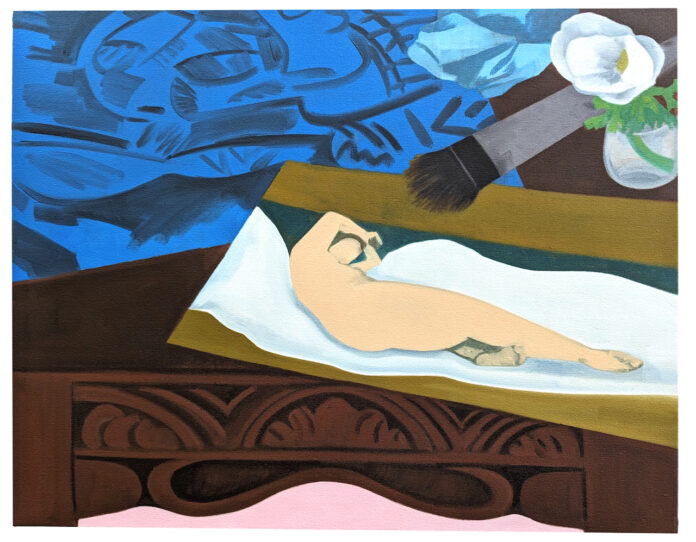Emerson Dorsch Presents Mel Davis: Six Years
Emerson Dorsch is pleased to present Six Years, a solo exhibition showcasing the work of Berkeley, California-based artist Mel Davis. The exhibition, featuring 30 pieces created over the past six years, opens with a reception on Thursday, September 19th, from 6pm to 9pm, and will be on view through November 2, 2024.
Six Years offers a captivating exploration of memory, history, and the ever-evolving nature of painting. Davis’s work delves into the complexities of these themes, inviting viewers to contemplate their own relationship to the past and the present. Through a variety of techniques and approaches, Davis creates a visual narrative that is both personal and universal.
Exhibition Details:
- Artist: Mel Davis
- Exhibition Title: Six Years
- Dates: September 19 – November 2, 2024
- Reception: Thursday, September 19, 6pm – 9pm
- Location: Emerson Dorsch, 5900 NW 2nd Ave, Miami FL. 33127
About the Artist:
Mel Davis is a Berkeley-based artist whose work explores the intersections between memory, history, and painting. Through a diverse range of techniques and approaches, Davis creates thought-provoking works that resonate with viewers on a personal and universal level.
Join us for the opening reception on September 19th and experience Mel Davis’s captivating exploration of time and memory.
Mel Davis: Six Years
Emerson Dorsch is pleased to present Six Years, a solo exhibition featuring the work of Berkeley, California-based artist Mel Davis. The exhibition, which encompasses 30 pieces created over the past six years, is an investigation of memory, history, and the evolution of painting.
Mel Davis approaches her practice by focusing on individual bodies of work. Her style transforms based on the topics she engages with. This method stems directly from how she looks at painting; she places an emphasis on observing the memories that arise each time she encounters a particular work. “It’s impossible to make a painting without thinking of past paintings. We are always in dialogue with images that came before us,” Davis says when speaking about how the culmination of imagery in our lives affects how artists work today. “In an age where there isn’t a hierarchy on how we can use images, artists can take from all different kinds of sources to create their own palette.”
In her exploration of painting, Davis often recreates works through a new lens, one influenced by, or infused with, memory. She turns to art history in order to create a conversation between the past and the present—although instead of longing for the past and feeling a sense of nostalgia, the artist describes her process, rather, as a commemoration of the past. In Book (after Matisse) (2018-2024), Davis pays homage to Henri Matisse by painting an image of a cover design that the famed artist produced for an exhibition catalog in 1951.
The original work was made of paper cut-outs and is a horizontal piece; Davis’s version is a vertical oil on linen of a different scale. She recalls the impact Matisse had on painting, transforming it in a way the world hadn’t seen before, and offering an escape from reality. In his post-WWII works, the artist’s use of bold color and abstract forms offered beauty and respite in the shape of domestic bliss in the middle of a still-devastated Europe.
Similarly, in other works from the exhibition, we are reminded of our relationship with Pablo Picasso, Ernst Ludwig Kirchner, and Sandro Botticelli. It’s as instant as taking that first glance—we immediately know the reference. But Davis’s works have an additional element that we may not be as familiar with. She adds her own reference, her personal memory comes into play, and we can see her recalling a certain sentiment or history which is her own. An image of a portrait may be flipped, a black on white work on paper becomes an oil on canvas painted blue, or the scale of an original work is made smaller (or larger). Whatever it is, we are now confronted with a layered perception of the work.
In Postcard from Italy 1 (2024), Davis includes a number of historical elements on one canvas. She’s looking at Sandro Botticelli’s The Annunciation (ca. 1485-92) because in this particular image of the Madonna and the Angel, she sees a rhythm in the figures. To her, the scene is less about a message from God, and more of a ballroom dance. Perhaps we wouldn’t have noticed this by looking at Botticelli’s painting, but in Davis’s version, it’s clearly part of the narrative. This form of playing with history, or as she calls it, “making a collision with history,” is emblematic of her work. She’s interested in using a variety of sources in her reproductions—in one instance she paints a Hellenic sculpture that may not actually exist, but she recreates a type of figure that we connect with because it already exists in our minds, in our collective memory.
Themes of femininity, delicacy, and tenderness are found in her paintings of hands holding flowers. This is her way of exploring, much like Picasso did, how much you can say with the least amount of lines and color. What can painting do, or describe; what can painting be; in its most abbreviated form? Beyond paintings of flowers, her still lives emphasize objects as an everyday universal truth. Here, the sources may be coming from the past, but these concepts are very much present today.
Taking inspiration from the Wolfgang Tillmans’s installation at the Albertinum in Dresden (2018), Six Years displays Davis’s paintings at different levels throughout the gallery walls with purposeful moments of pause in between works—a thoughtful consideration of how they interact with each other and the space. The exhibition design presents us with a rich tapestry of works that reflect both personal and historical dimensions. In this way, it’s not just her paintings, but the installation, too, looks to the familiar as a reference to build a new narrative structure.
September 2024, Mel Davis: Six Years, by Ana Clara Silva




